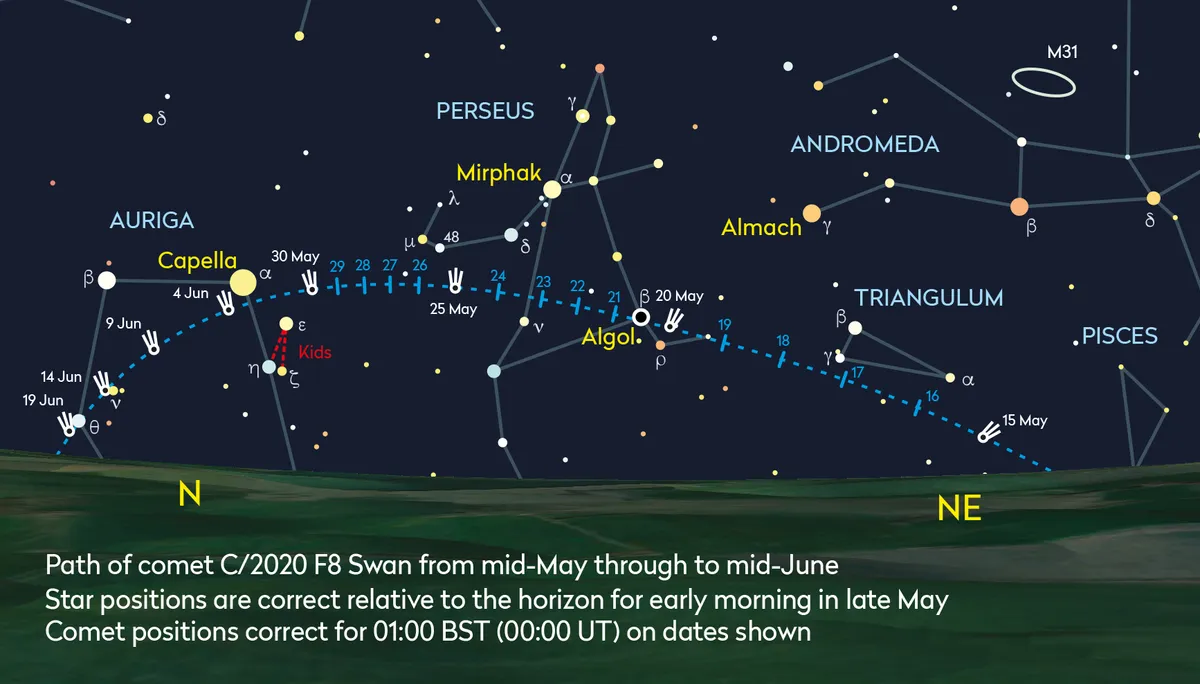Comet C/2020 F8 Swan will be gracing the UK’s skies during May and into June 2020, although it might prove tricky to spot. Discovered in images taken by the SWAN camera aboard the Solar Heliospheric Observer (SOHO) spacecraft on 25 March 2020, the comet reaches perihelion on 27 May.
At the start of May, it was estimated to be a fraction brighter than mag. 6, putting it within naked eye territory. By late May, preliminary estimates suggest it may brighten to around mag. 3.
Observing it will be a balancing act due to where the comet is located in the sky versus the onset of evening, morning and summer twilight.
Read more about comets:
- How to see and photograph comet C/2017 T2 PanSTARRS
- The story of Comet Hale-Bopp
- The story of Comet Shoemaker-Levy 9
Its track from the start of May has it passing through western Cetus, crossing Pisces and then moving into Triangulum on the morning of 15 May.It leaves Triangulum on 18 May, crossing into Perseus.
It’ll be very close to Algol (Beta Persei) on the nights of 19/20 and 20/21 May. If you’re familiar with Algol, this will help locating the comet on these nights. As luck would have it, the comet is expected to reach its peak brightness between 20-22 May.
As it continues to move east among the stars, its track takes it south of the curve of stars formed from 48, Mu and Lambda Persei, the shape representing the northern knee of the Greek Hero.
On the night of 29/30 May, comet C/2020 F8 Swan moves into Auriga approximately 4.5 degrees to the west of Capella (Alpha Aurigae). It continues east, curving south as it goes, to pass one degree south of Capella on the night of 2/3 June.
Throughout the rest of June, the comet arcs into a southeast trajectory taking it one-quarter of a degree from Nu Aurigae on the night of 13/14 June, and around 4 arcminutes from Theta Aurigae on the morning of 18 June.
Visibility for this comet will be complicated by the part of the sky it is in and the proximity of its appearance to the Northern Hemisphere’s summer solstice on 20 June.

The darkest part of the night will be around 01:00 BST (00:00 UT). This is when the Sun will be furthest beneath the horizon.
However, the comet’s altitude will not always be optimal at this time. In addition, the altitude of the comet above the horizon will be better the further north you are located within the UK.
This is unfortunately offset by the fact that the Sun’s apparent distance below the northern horizon is lessened the further north you are, leading to brighter skies.
From the centre of the UK, the first sighting of C/2020 F8 Swan may theoretically be made in the middle of May as the comet passes into Triangulum.
Its altitude will be low when the sky is dark enough to see it; reaching 3.5 degrees in the early hours, possibly increasing to 5 degrees before being totally wiped out by the brightening dawn twilight.
The lighter skies further north will mean that you’ll need to look for the comet earlier in the night and at lower altitude.
From southern England, the situation is marginally better thanks to the Sun being further below the horizon, the comet possibly making it up as high as 7 degrees altitude before being lost to the mid-month morning twilight.
For the close approach to Algol on 19/20 and 20/21 May, different strategies will be required depending on how far north or south you are located.
For those in the north, the period around 01:00 BST will give the darkest skies, the comet being 6 degrees up from Glasgow at this time.
From the middle of the UK, 01:00 BST is darkest but the altitude of the comet will be extremely low.
Here you may catch it slightly below 4 degrees altitude in the darkening evening twilight, dipping to less than 3 degrees altitude when due north, but managing to reach 8 degrees just the dawn twilight gets too bright.
In the south, when the comet is close to Algol it barely scrapes the horizon in the middle of the night. Here, the best strategy is to observe in the early hours when the comet may attain an altitude of around 8 degrees in reasonably dark skies.
The period from 25 May into early June presents perhaps the best opportunity to spot the comet for those of us living in the UK.
From the south of England, the lower altitude of the Sun and darker nights will pay dividends as the comet moves from Perseus into Auriga.
Here, the best observing window will be from 90 minutes before the Sun reaches its lowest point in the sky, through to 90 minutes after.
The variation in altitude over this window will be around 2 degrees, 7 degrees at the lowest point and around 9 degrees at the highest.
From the centre of the UK, the window will be slightly shorter – possibly 70 minutes either side of the Sun reaching its lowest point below the northern horizon.
From the north of the UK, the bright twilight sky will interfere badly and the best strategy here will be to take advantage of a higher comet altitude at the darkest point in the middle of the night.
Pete Lawrence is an experienced astronomer and a co-host of The Sky at Night.
